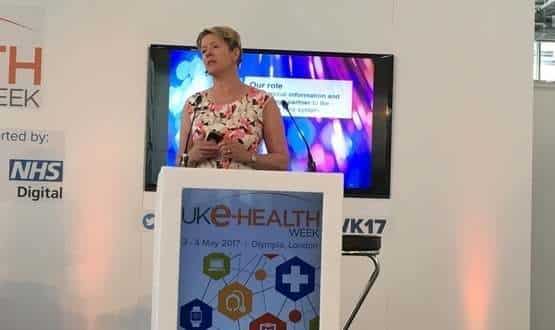NHS Digital planning “big drive” on clinical terminology standardisation
- 5 May 2017

NHS Digital will be having a “big drive” on standardising clinical terminology across health and social care, according to one of its leaders.
Beverley Bryant, the organisation’s director of digital transformation, told delegates at the UK e-Health Week conference that such standardisation was critical for data sharing.
“What is the point of being a national health service if we don’t capitalise on the national nature of it through standardisation of our clinical terminology?”
She told the London audience on Thursday that: “I need SNOMED clinical terminology to become the central building block of information sharing across health and social care”.
In October 2015, NHS Digital (then known as the Health & Social Care Information Centre) said that all primary care systems needed to switch from Read Codes to the SNOMED system for clinical technology by end of December 2016, with the rest of the healthcare system following suit by April 2020.
Both systems are sets of numerical machine readable codes and human readable descriptions which can be used to uniquely identify clinical concepts.
Bryant said that primary care was not the issue – “it’s in secondary care that we’ve got a lot more work to do”.
She also said that NHS Digital has started work on a social care dictionary for SNOMED terminology.
Bryant said that standardisation “does reduce data collection burdens and transform how we share information and data”.
A few examples were given of how datasets were being linked across the healthcare system, including via the Child Protection – Information Sharing (CPIS) programme.
CP-IS is now receiving 1,000 hits a week between social care and selected healthcare teams, according to Bryant, and was described as a “really useful intervention for frontline patient care”. However, the rollout of the system has been slower than was initially hoped.
NHS Digital’s commissioning last year of the Professional Record Standards Body to develop standards for e-discharge summaries from emergency departments to GPs – it will do so in partnership with the Royal College of Physicians – was also referenced.
Bryant concluded the speech by saying whatever the result of the upcoming general election, the momentum and pace that is now in health IT cannot be halted.
Throughout the conferences, questions to speakers from national bodies were not allowed due to purdah.




10 Comments
SNOMED development has been badly done with errors of concept duplication, hierarchy errors, wrong maps to Read version2 – getting better and Read 3 still very bad
Until this is tidied and validated forget about using it in earnest
Snomed ct is already with us(behind the scenes on the GP systems), the plan is for it to have taken over read BY april 2018. (thats not long by my reckoning). It is well thought out ,well structured, and is far better than read. A few problems will be encountered but we should have gone to snomed ct years ago. I think its fantastic and a major step forward.
You need drivers for using SNOMED and it’s ValueSet (lists of SNOMED codes). If it’s used in reporting or interoperability (both make heavy use of non SNOMED codes), we will see adoption.
NHS England/Digital/HSCIC have had opportunities to start doing this. Paperless 2020 could have included guidance on technical implementation e.g. categorise the documents using one of the 200-300 SNOMED codes in DocumentType dataset (which IHE UK, HL7UK, OpenEHR, etc all think you should be using).
Terminology is only a small part of the problem. There is very little proper change control, training & processes to ensure consistent and effective use of any coding system.
If everyone used their own coding but just published their datasets / dictionaries and had a proper change control process that saw updates properly managed and published we’d be a lot better off.
The complexity of SNOMED means that even if everyone is using it if they are using it in a consistent and controlled manner we’ll still have many of the problems of today.
I agree, Dan. Even with the current Read codes, which have much fewer codes than Snomed, getting consistency is difficult across even such a small organisation as a practice.
We use templates and protocols to try to ensure that a limited code-set is used for most conditions. Without this, searches and recalls are near impossible. Unfortunately, apart from codes needed for the GP QOF scheme, there is little or no standardisation between practices, let alone with other organisations.
The increased number of codes and the complexity of SNOMED add to the problem. I have played with demo code-picking systems but none I have tried so far offfer to guide you to a preferred code, simply listing possible matches.
When it comes to coding, sometimes less choice is a better option than a pill for every ill or a code for every node.
The problem remains that medical terminology will keep on changing because we still do not have a proper link between names, mechanisms and outcomes for many disease processes, problems of pseudo mathematical or pseudo scientific classification systems, and the lack of useful modifiers that properly intergrate with main codes ( left, right, yes, no, non, working, true, false, etc) and local flavours of SNOMED caused by lack central hierarchy and lack of linked definitions.
Terminologies are constantly updating which is why a strong terminology management process needs to be in place in organizations that use terminologies. Updates comes at reliable times and a good update process is needed within the organization. The ability to post coordinate in terminology accommodates the ability to link laterality and other modifiers to concepts. Depending on the use of the terminology, concepts between terminologies can be created and accommodated within systems.
“The problem remains that medical terminology will keep on changing…”
Having worked with SNOMED CT for over a decade, I’d like to contribute my perspective on this. Medical terminology will indeed change over time. This is because medicine changes, and so do human perspectives of it. This is less of a challenge than you would imagine. SNOMED is particularly well suited to a changing environment, because it has robust ways to manage its own evolution. SNOMED is intended for use in software to structure clinical data. The management of change in data is therefore an engineering problem, which engineers are well trained to solve. Of course engineers need help from clinicians, especially with decisions that are mostly clinical. Again, less of a problem that you would think, because engineers and clinicians can work together very well.
Robert Turnbull
http://www.turnbull.consulting
She told the London audience on Thursday that: “I need SNOMED clinical terminology to become the central building block of information sharing across health and social care”.
Should that be WE need? Perhaps if some people in NHS Digital stopped acting like an arms length agency and put focus on delivery, therefore realising it’s a we – they might turn around their questionable performance.
My thoughts exactly, although I would have suggested “MY DOCTORS” or “MY CARE PROFESSIONALS” or even “MY PATIENTS”!
Comments are closed.